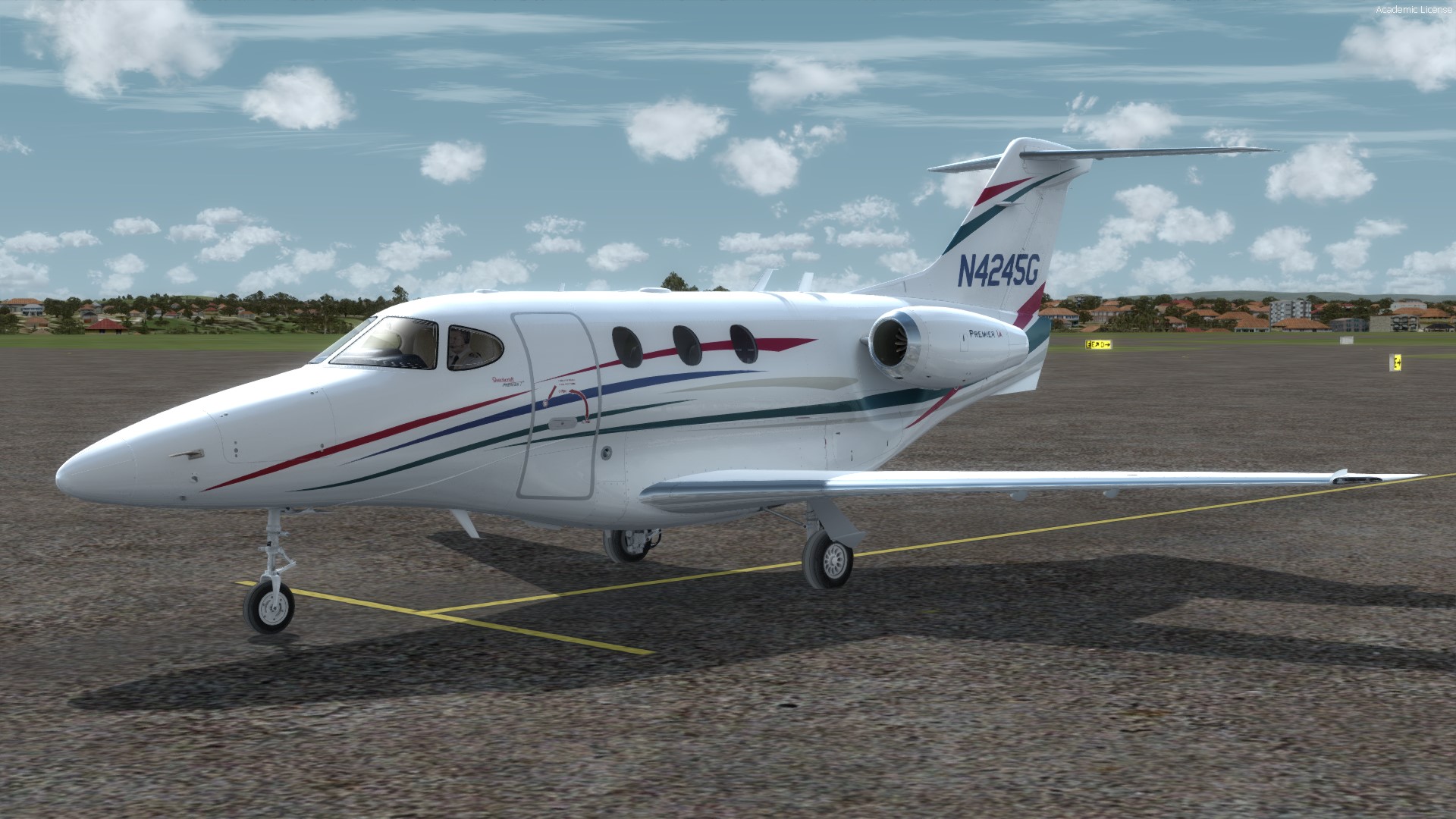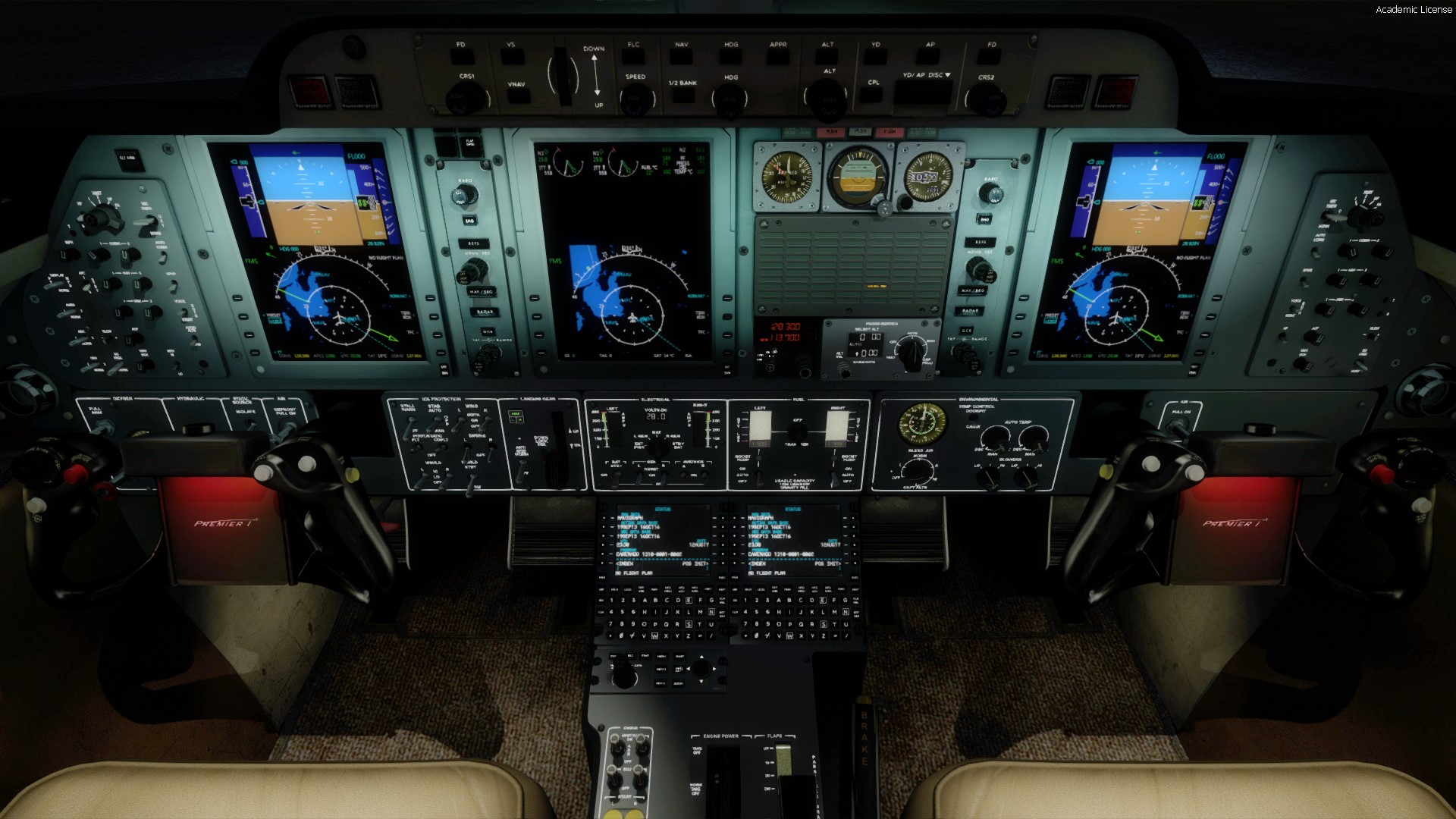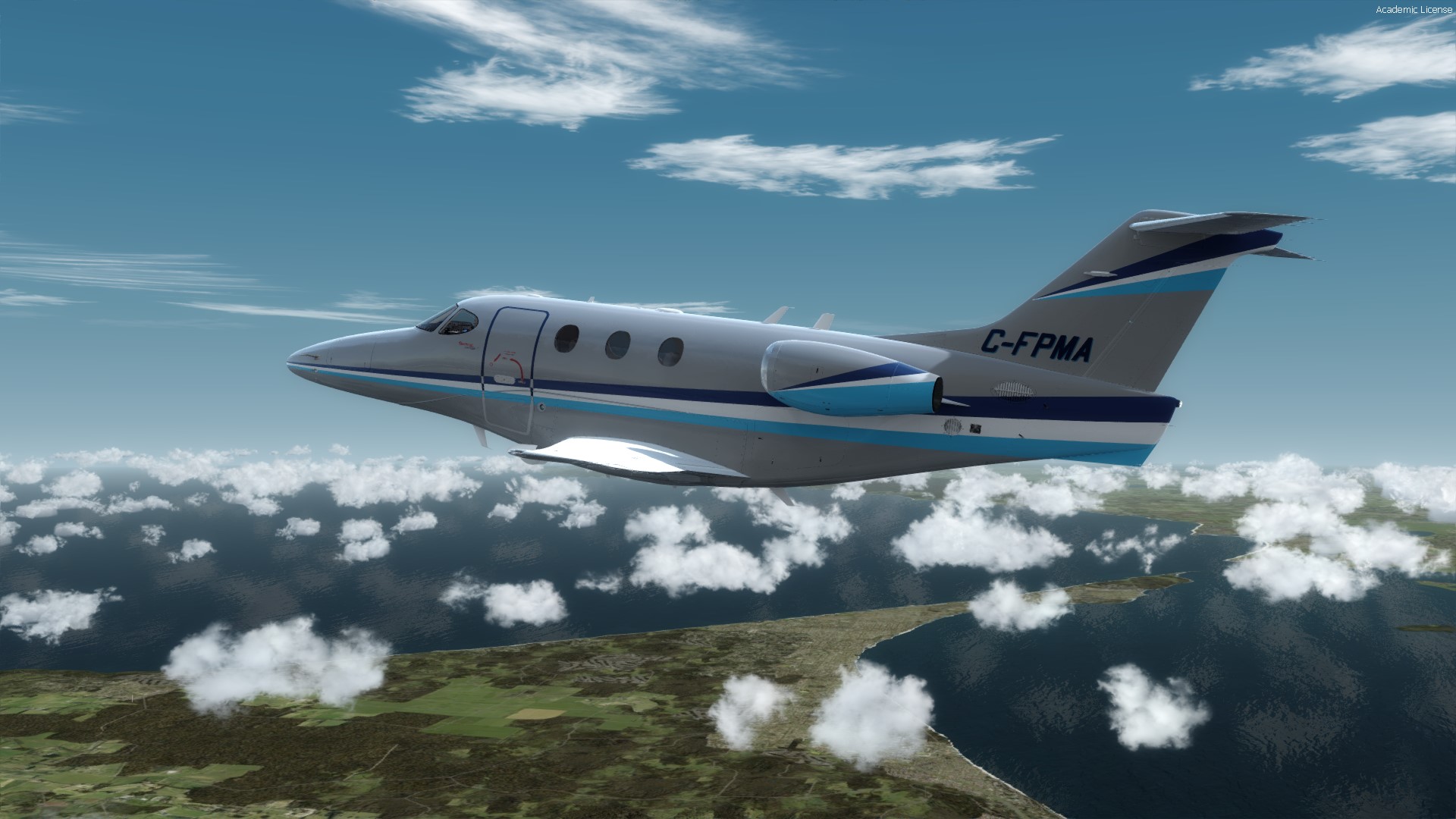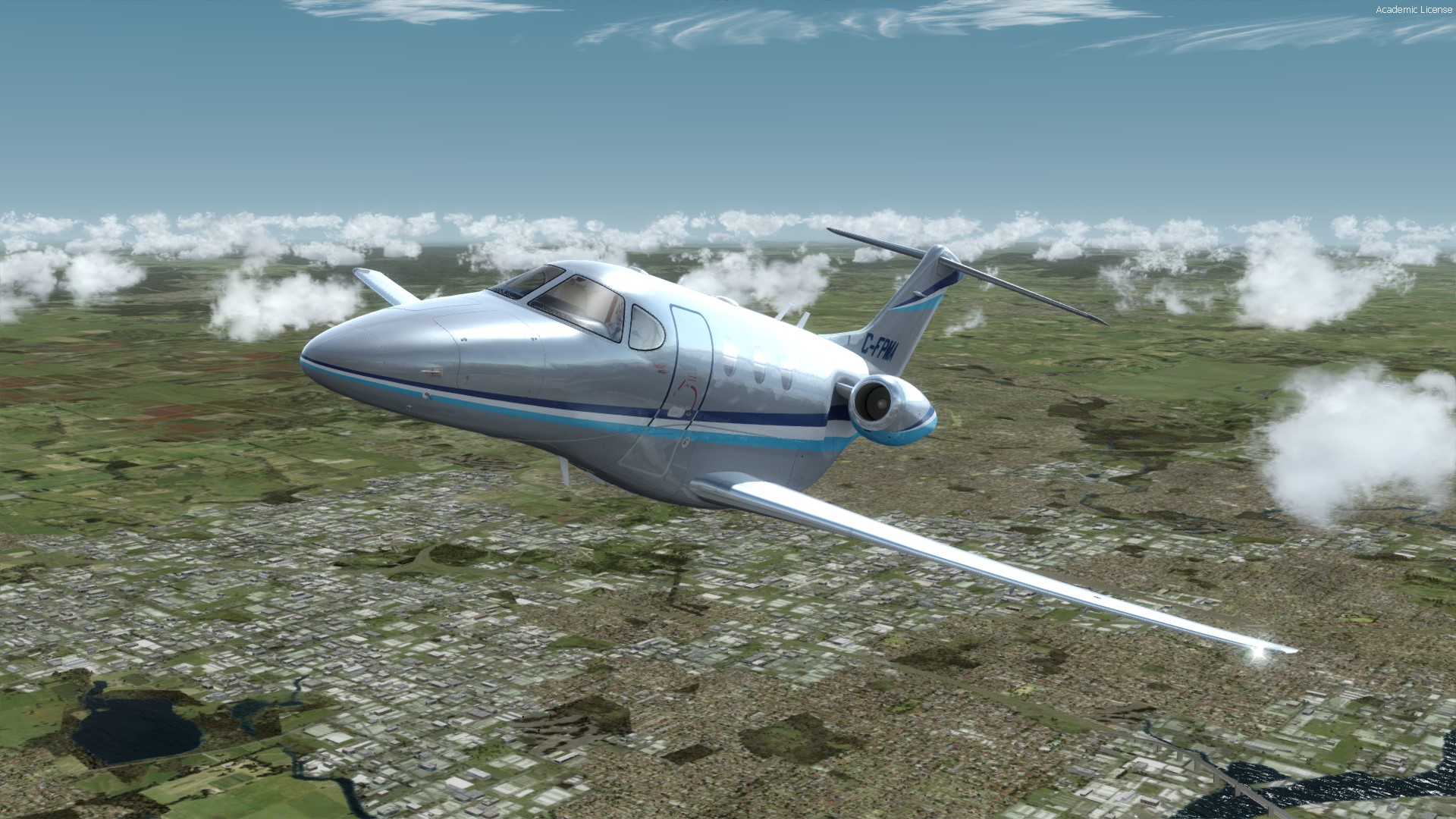Introduction
The light jet category of aircraft has been an emerging and, very much, an evolving aircraft category, particularly over the last two to three decades. The Bombardier Learjet and Cessna CitationJet families are synonymous with this category along with a range of other offerings from other established aircraft manufacturers. The 390 Premier IA is one of these offerings. A twin engined, light jet, the 390 Premier IA has had a rather quiet rise to fame, but it has established itself as a high performer in this category, setting many records along the way.
The flight sim community is increasingly benefiting from a development focus in the light jet category in recent years and this focus is delivering an excellent range of diverse offerings. Carenado's release of the 390 Premier IA has further extended the choice in this category, providing simmers who enjoy this category another tempting offering. The 390 Premier IA is a beautiful aircraft with brilliant performance and handling and it is an aircraft worth serious consideration.
History
The 390 Premier IA is a twin engine, low wing cantilever monoplane with a T-tail, in the light jet aircraft category and intended for a light business role. It is constructed with a high strength, composite, carbon fibre / epoxy honeycomb fuselage with seating for up to seven passengers and is powered by a pair of Williams International FJ44-2A turbofan, 2,300 lbf engines.
Design of the Premier I began in early 1990 with construction of the first prototype commencing in late 1996. The prototype first flew on 22 December 1998 with FAA Type Certification being issued on 23 March 2001, and on 22 September 2005 for the upgraded Premier IA. The original design concept for the aircraft was to produce the most comfortable, single pilot certified aircraft in its class. The former was achieved by having an interior which redefines first class, in a cabin with a very generous cabin cross section measuring 5.5 feet in diameter, approximately nine inches larger than the Cessna CitationJet series and Learjet 31A, the Premier's closest competitors back in 2001. Both the Premier I and Premier IA can be certified as light aircraft for operation by a single pilot. The Premier IA delivered a new cabin interior and improved systems and production for the aircraft ended in 2013 after a production run of 298.
Availability and Installation
The Carenado 390 Premier IA is currently available direct from Carenado and Carenado resellers as a download only product (some resellers also offer a master back-up CD / DVD service for a minor additional cost). It is priced at US$39.95, or the equivalent on currency cross rates. The download file size is 501MB and it requires 1.1GB of HDD space for installation. An activation key is issued on purchase and is used during installation and the installation process is intuitive and seamless.
Model Features
The model features listed by Carenado for the 390 Premier IA are typical of models in the Carenado range and include:
high quality 3D model;high definition textures (4096 x 4096);
ProLine21 avionics suite;
Navigraph database (October 2013), updatable;
ground power unit (GPU) simulation feature (with volts indicator);
high quality, digital 3D sounds;
realistic night lights effects on panel and cockpit; and
realistic behaviour.
Visual Appearance
General Overview. The squat design of the 390 Premier IA belies its high performance and characteristics. From the slender nose, the fuselage at the wing root appears disproportionately bulky for the aircraft's overall length, this design feature providing the aircraft's generous cabin cross section and spacious interior cabin. As ungainly as the Premier IA's appearance is, it is not to be underestimated once in the air.
Exterior. The 390 Premier IA exudes corporate luxury from outset. The design is not dissimilar to others in the category, but still, the extended, pointed nose, bulky wing root centre section, and T-tail give the aircraft a somewhat unique appearance.
Interior. Carenado has modelled the interior beautifully, capturing the truly, first class, corporate luxury which the design set out to achieve. The textured, heavily padded, leather seating, highly polished wood panelling, carpet, and padded side panels give the impression that no expense has been spared, with the enlarged windows affording excellent external views. This is an environment befitting the successful corporate businessman / businesswoman or entrepreneur, and the quality is consistent with that seen in the Carenado model range. This is a cabin presented in perfect condition, exactly as you would expect for something so luxuriously appointed. The modelling and quality of detail creates an appearance and atmosphere which really make you feel and appreciate what the real world aircraft interior is like.
Flight Instruments and Systems. The cockpit of the 390 Premier IA exudes a level of technical quality to match the high quality luxury of the of cabin. The ProLine21 avionics suite is the centre piece of this technical quality, presenting all information required for the operation of the aircraft. Whilst it might seem daunting at first, with familiarity comes confidence, and the operation of the integrated ProLine21 suite soon becomes second nature. As daunting as it may seem, the operation of the ProLine21 avionics suite is addressed in good detail in the manual, so reading it is a must, unless you have a natural ability to stumble your way through with such technology.
Models and Liveries. The 390 Premier IA is provided in a single model with five individual liveries (a selection only shown below). Each aircraft has a unique aircraft registration number and there is an additional blank texture for aircraft painting enthusiasts. Displaying high quality, the surface textures, reflections, and shadings, along with additional dirt, oil, and grease stains, give each aircraft a realistic appearance. Additionally, each livery is also presented in a Lite model for better frame rates on lower end systems.
Summary, Issues, and Variations. Carenado's rendition of the 390 Premier IA is highly detailed and accurate, the visual quality is excellent, and it provides a faithful representation of the real world aircraft. Any noted visual variations were minor and are considered to be related to real world production variations or a degree of artistic licence on the part of the developer. A specific issue was noted with the contact points for the main wheels in that the contact points are set too low, giving the tyres the appearance of being very flat / underground. All elements of the cockpit are clear and easy to read, with various alternative cockpit camera views available to provide more detailed clarity. Any noted issues and variations with cockpit functions and operation were considered minor and / or in the interests of simplifying the function for practical flight simulator use. Specific attention to the manual for the correct operation of the ProLine21 avionics suite will ease any frustration or confusion in its operation.
Animations, Lighting and Sounds
The animations of the primary and secondary control surfaces and other moving elements on the 390 Premier IA are all modelled faithfully and include:
primary control surfaces – ailerons, elevator, and rudder;
secondary control surfaces – flaps;
others – elevator and rudder trim tabs, cabin door, and baggage compartment doors; and
various static elements.
The lighting and lighting effects on the 390 Premier IA are excellent and are a realistic representation of the real world aircraft. The cockpit and panel lighting illuminates the instruments nicely and the cabin lighting provides a warm ambience. The engine sounds are a very good representation, delivering a sound reasonably representing that of the Williams FJ44 turbofans, and with good stereo separation with view movement in the Virtual Cockpit view and external views.
General Characteristics and Performance Specifications
The general characteristics and performance specifications for the 390 Premier IA are provided in the table. This is based on data from the official 390 Premier IA Pilot Operating Handbook, data provided by Carenado, and general research sources. Some of this data varies between sources and also may be an approximation due to variances in data and the specific aircraft modelled by Carenado.
General Characteristics
| Crew | One / Two |
| Passenger Capacity | Up to seven |
| Length | 46 ft 0 in (14.02 m) |
| Wingspan | 44 ft 6 in (13.56 m) |
| Height | 15 ft 4 in (4.67 m) |
| Empty Weight | 7,996 lb (3,627 kg) |
| Fuel Capacity | 536 US gal (2,028 l) |
| Maximum Take-Off Weight (MTOW) | 12,500 lb (5,670 kg) |
| Power Plant | 2 x Williams International FJ44-2A, turbofan, 2,300 lbf (10.23 kN) |
Performance Specifications
| Maximum Speed | 461 kts (530 mph, 854 km/h) at 33,000 ft |
| Cruise Speed | 440 kts (506 mph, 815 km/h) at 33,000 ft (2,750 m), 75% power (TAS) |
| Stall Speed | 96 kts (110 mph, 178 km/h) full flaps, gear down, engine at idle (CAS) |
| Range | 1,430 nm (1,645 mi, 2,648 km) |
| Service Ceiling | 41,000 ft (12,500 m) |
| Rate of Climb | 2,500 ft/min (762 m/min) |
Flight Performance
A specific Test Flight was conducted to test the flight performance of Carenado's 390 Premier IA. The flight was conducted in clear weather with a full fuel load and the aircraft at maximum take-off weight (MTOW). A cruise altitude of 33,000 ft was adopted and the route distance was particularly chosen to provide a basis upon which to test the range characteristics of the Premier IA.
The aircraft was easy to taxi. With flaps set at 10°, aircraft rotation occurred at approximately 125 KIAS and effortlessly lifted off the runway, with a climb out which was consistent with the performance specifications for the aircraft. The Premier IA is very agile and it quickly establishes on the climb to cruise and climbed effortlessly until the aircraft was established at the cruise altitude.
During cruise, a power setting was established for cruise as per the performance tables. This cruise setting produced an average speed, fuel flow rate and an endurance reasonably consistent with the performance tables and the characteristics of the aircraft. Any noted variances in performance were minor and had negligible impact on the operation of the aircraft. The Test Flight confirms the modelling of the aircraft for speed and range performance to be reasonably accurate.
Configured for landing, with full flaps, and trimmed for a descent rate of approximately 500 ft/min, the aircraft's approach speed was approximately 125 KIAS and it touched down at approximately 115 KIAS, with a landing roll out comparable with the specifications for the aircraft.
In testing the accuracy of the instruments, based on the measured Test Flight, the speed indications on the airspeed indicator, were consistent with the averages measured. Additionally, when establishing a set rate of climb on the vertical speed indicator, the respective gain in altitude on the altimeter was achieved within the measured minute, and a standard rate turn was achieved within the measured two minute period using the turn coordinator.
The performance of Carenado's 390 Premier IA was excellent in flight, displaying the expected general flight characteristics of this aircraft. The aircraft is fast and nimble, yet its handling is smooth, making it a delight to fly. It is responsive to control inputs and, if flown manually, it trims out nicely for level flight and when established on approach. Overall, the aircraft model displays an accurate rendition of the flight characteristics and performance expected of this type of aircraft.
Documentation
There are six primary manuals / documents provided in Adobe Acrobat format (.pdf) for the 390 Premier IA:
Carenado ProLine21 – this 13 page document details the operating of the ProLine21 avionics suite;
Flight Guidance System – this five page document details the operation of the flight guidance system;
Carenado 390 Premier IA Performance Tables – this 41 page document details the performance tables for the aircraft;
Carenado 390 Premier IA Normal Procedures – this 15 page document details the procedures for the normal operation of the aircraft;
Carenado 390 Premier IA Emergency Procedures – this 26 page document details the emergency procedures for the aircraft; and
Recommended Settings – this two page document details recommended display and realism settings for the aircraft.
Value for Money
At US$39.95, the 390 Premier IA is at the upper end of the Carenado price range. However, there is a lot to this aircraft with the quality to match. On a value for money assessment, the Carenado 390 Premier IA is considered very good.
Simulator Performance
The aircraft model performed excellently within the existing settings I have in Prepar3D. I have most of my settings set very high and there was no need to make any adjustments. There was no discernible frame rate impact directly attributable to the Carenado 390 Premier IA and Prepar3D continued to perform smoothly.
Technical Requirements
This version of the Carenado 390 Premier IA is for FSX / FSX SE / P3D v3 or v4 only. Other specified technical requirements are as follows:
Windows XP (with SP3 installed), Vista, or Windows 7 (32 or 64bit);
Microsoft Flight Simulator FSX with SP1 and SP2 installed (or Acceleration Pack), FSX Steam Edition, or Lockheed Martin Prepar3D (v3 or v4); and
Pentium V, 3GHz or similar, 2GB RAM (4GB recommended), 512MB graphics card, and 1.1GB available HDD space.
Review Computer Specifications
The specifications of the computer on which the review was conducted are as follows:
Intel i7 990X Extreme 3.46GHz;
NVidia GTX980 G1 Gaming, 4GB, 1228/1329MHz;
12GB, Kingston DDR3, 2000MHz, XMP T1 CL9 HyperX;
Windows 7, (64bit); and
Lockheed Martin P3D Version 4.
Additional Major Add-ons. Active Sky for P3Dv4, Active Sky Cloud Art, SPAD.neXt, FS Global Ultimate region series, Orbx FTX Global BASE, Orbx FTX Global VECTOR, Orbx FTX Global openLC Europe, Orbx FTX Global openLC North America, Orbx FTX Global openLC South America, Orbx FTX Global Trees HD, Orbx region series, and Orbx airport series.
Conclusion
The 390 Premier IA is a fantastic aircraft and Carenado have delivered another highly detailed and beautifully accurate model. Replete with all the luxury of a first class cabin and the ProLine21 avionics suite, the 390 Premier IA is a lot of aircraft in the light jet category. Its flight performance is exemplary, and its handling and ease of flying is nearly unmatched. This is an aircraft which feels very natural when you take the controls, making it a pleasure to fly.
Verdict and Scores
Verdict
| Another great aircraft from Carenado, the 390 Premier IA exudes luxury with handling characteristics which make flying it a pleasure. |
Scores
For |
Against |
Category |
Score/10 |
|---|---|---|---|
| High quality textures and attention to detail. | No major issues. | External Model | 9.5 |
| Thorough documentation. | Internal Model | 10 | |
| Very good value for money. | Sounds | 9.0 | |
| Flight Characteristics (does it fly by the numbers) | 9.5 | ||
| Flight Dynamics (does it feel like what it looks like) | 9.5 | ||
| Documentation | 10 | ||
| Value for Money | 9.0 |
Overall Score

The Carenado 390 Premier IA is awarded an overall Mutley's Hangar score of 9.5/10, |






















